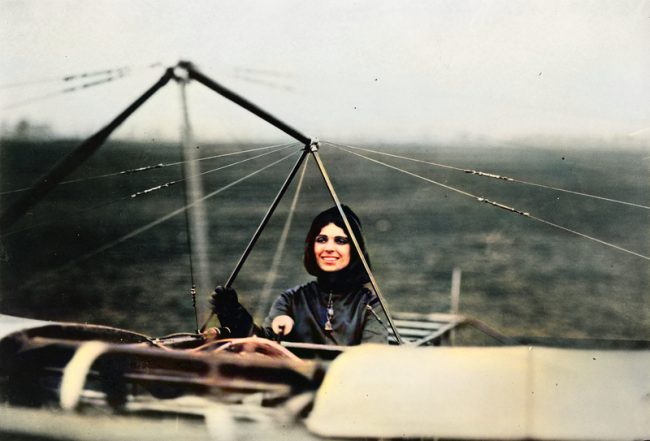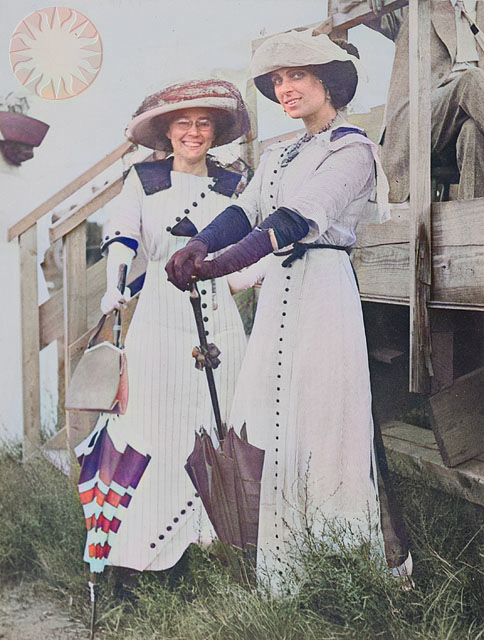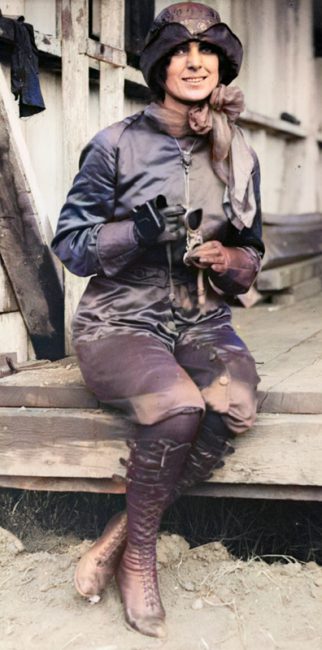
Harriet Quimby (1875-1912) in the Moisant monoplane she learned to fly
On April 16, 1912, Harriet Quimby became the first woman to fly across the English Channel. She was the the first woman to gain a pilot’s license in the United States. Although Quimby lived only to the age of thirty-seven, she had a major influence upon the role of women in aviation.
Harriet Quimby Background
Harriet Quimby was born into a farmer’s family in Michigan and moved to San Francisco in order to become an actress. However, Quimby later decided to become a journalist instead and continued her career in New York City. There, she wrote often for the Leslie’s magazine. Quimby began to travel and earned herself a great reputation as a journey reporter and photographer traveling across Cuba, Europe, Egypt, and Mexico.

Matilde Moisant (left) and Harriet Quimby, the first two women in the United States to obtain pilot certificates (photo circa 1911–1912)
First Flight Lessons
Around 1906, Harriet Quimby discovered her interest in fast vehicles during a work on the Vanderbilt racetrack. Soon, she bought her own car and became known as a very successful young woman, who traveled around the world and even managed to support her family financially. It is assumed that Quimby’s interest in aviation was initiated in 1910 when she visited a flight contest at Belmont Park. The young woman got to know John Moisant, who was back then a very popular aviator and teacher and became known for his flight around the Statue of Liberty. As the Wright Brothers did not take any female students at the time, Quimby was very pleased that Moisant agreed to teach her.[4]

Harriet Quimby in 1911
The Aviator
Next to her increasing interest in flight, Harriet Quimby also began writing screenplays for silent movies and continued her journalism career. On 1 August, 1911, she received her pilot license as the first woman in the United States. In the Leslie’s, she wrote about her adventures as the first woman flying over Mexico and as the first woman achieving a flight at night time. Also, she fantasized about the future of aviation and imagined big flight airlines that would carry thousands of passengers every day. Her next big goal was the crossing of the English Channel from Great Britain to France, but she kept this plan secret for a while. Only Louis Blériot,[5] who crossed the channel in the other direction in 1909 knew about her plans and allowed Quimby to use his plane. The highly motivated Quimby faced bad luck on 2 April, 1912. Gustav Hamel took Eleanor Trehawke Davie with him while crossing the channel and Quimby could not be the first woman to achieve this. However, she continued her plans and became the first female pilot to make it across the channel. Even though many came to applaud the female pilot for her achievement, it played only a minor role in the media, since the sinking of the Titanic, which occurred only two days before filled all newspapers back then.
Sudden Death
After Quimby had returned to New York City, she planned to take part in further aviation competitions. On July 1, 1912, she flew in the Third Annual Boston Aviation Meet at Squantum, Massachusetts. Although she had obtained her ACA certificate to be allowed to participate in ACA events, the Boston meet was an unsanctioned contest. Quimby flew out to Boston Light in Boston Harbor at about 3,000 feet, then returned and circled the airfield. William A.P. Willard, the organizer of the event and father of the aviator Charles Willard, was a passenger in her brand-new two-seat Bleriot monoplane. At an altitude of 1,000 feet (300 m) the aircraft unexpectedly pitched forward for reasons still unknown. Both Willard and Quimby were ejected from their seats and fell to their deaths, while the plane “glided down and lodged itself in the mud”.[7,8]
Harriet Quimby: an American Hero, [11]
References and Further Reading:
- [1] Harriet Quimby at the National Aviation Hall of Fame
- [2] Harriet Quimby at Famous Scientists
- [3] Miss Quimby Flies The Channel
- [4] The Wright Brothers Invented the Aviation Age, SciHi Blog
- [5] Louis Blèriot’s famous Flight across the English Channel, SciHi Blog
- [6] Harriet Quimby at Wikidata
- [7] Harriet Quimby death reported in the Fort Wayne Sentinel, Fort Wayne, Indiana, July 2, 1912
- [8] “Miss Quimby Dies In Airship Fall. Noted Woman Aviator and W.A.P. Willard, Passenger, Are Thrown 1,000 Feet”. The New York Times. July 2, 1912.
- [9] “Miss Quimby Flies The Channel”Flight April 20, 1912
- [10] DiMeo, Nate (April 20, 2014). “Remembering Harriet Quimby, A Daring Female Pilot”. npr.org. NPR.org.
- [11] Harriet Quimby: an American Hero, TheAvWriter @ youtube
- [12] Wikidata Timeline for Female aviation pioneers born before 1900






It’s unfortunate she passed away but she is still an inspiration for many women today who can pursue a career in aviation as they learn about her and realize that even they can fly too.
Thank you very much for your comment! This encourages us also in the future to feature more women pioneers in science and technology.
Best,
Harald
Pingback: Whewell’s Gazette: Year 3, Vol. #35 | Whewell's Ghost